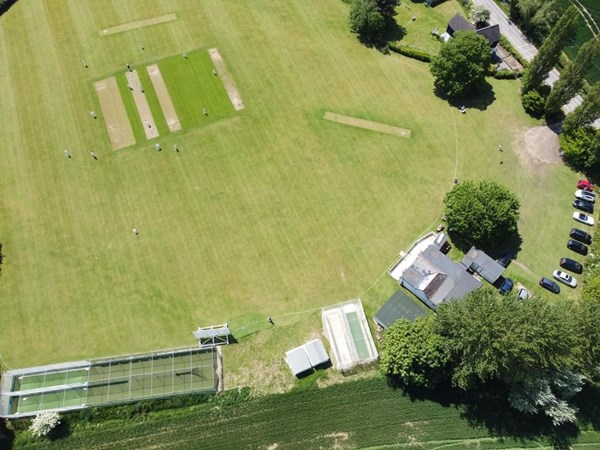A Hundred and Twenty-Five Years of Cricket at High Roding
by Terry Owers

IN 2015, the Club celebrated 125 years of playing cricket in the village of High Roding or as it was previously known in 1890, High Roothing. The first known pitch was set up in the meadow opposite Ware Farm at the south end of the village. Little is known of those early years in the Club’s history, but it can be assumed that some track was cut, marked out for the pitch with the fielding area being covered by the longer grass. One’s thoughts would lead you to expect that the outfield would be grazed by cattle, horses with perhaps chickens as well, all leaving tell-tale problems for players on Saturday afternoons. Sunday cricket as we now know it would have been frowned upon at that time. The nearby Black Lion Pub appears to have been a focal point where players partook their teas by invitation of landlord, Jack Little.
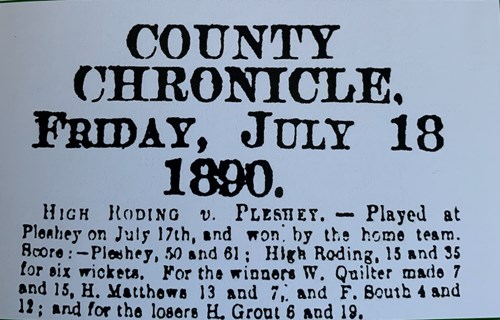
The Club remained playing on this site up until 1907 when it moved to a rather out in the wilds field at Barnston House Farm, here they remained until the outbreak of the Second World War. Again the Club enjoyed a cut area, which by now had become larger and protected against grazing horses, the outfield being of longer grass. The boundaries were short behind the wickets and it was common practice for batsmen to try and loft the ball over the hedge into the cornfields, hence long delays while the ball was retrieved. During this period players generally travelled ready to play usually arriving on bikes with boots slung over the handlebars. Tea was the highlight of the afternoon, provided by a wife or friend of a player and consisted of sandwiches with fruit cake and as a much tea as you wanted for 3d (1p) player. Subscriptions for membership were around 2 shillings and 6 pence to 3 shillings, or 15p in today’s money. During the course of the War, like many other Clubs the field at Barnston House was ploughed out in the interest of the Nation’s food supply.
On reforming the Club after the War the first priority was to find a new home. An approach was made to the Parish Council for the use of the meadow in the centre of the village which was under their control. This field was later purchased by Mr. R. Simpson a member of the Club. It was here the Club reformed and settled for the next four years, while a Mushroom Farm developed and it was indeed a sad day for the Club when they were asked to leave because of encroaching greenhouses.
This quick change to a new ground was but a short move to a meadow behind Roding Hall Farm by kind permission of the Wylie Family. It was in April 1950 that preparation was started to provide a wicket for the opening game in May, much work was successfully carried out. It was here in 1951 that the club purchased their first Pavilion, at a cost of £48-11-10d. The conditions were far from ideal for the Club in many respects with a long walk to the W.I. Hall where teas were taken. However, the Club stayed on this site for the next 10 years, even though they were unable to cut the ground because of the need to graze cattle.
The image below shows club’s first pavilion, costing £48.11s.10d
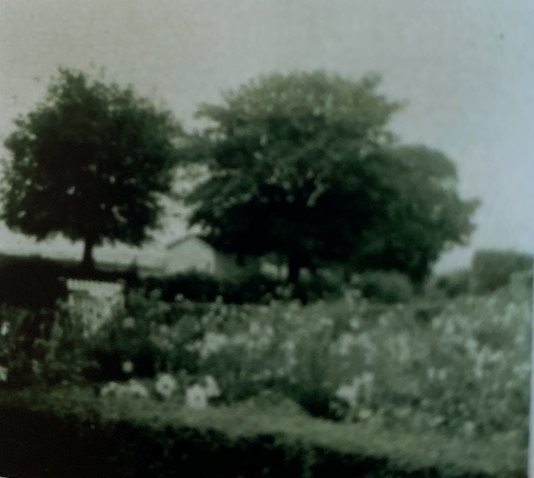
So it was a great relief, in 1959 when the Club were offered the opportunity to use a field just outside the village beyond the Crossroads heading out towards Gt. Dunmow. The owner Mr. Gordon Simmons made this offer on the understanding that the Club would have the field to play cricket for as long as they wanted. So it was with much enthusiasm that the Club set about preparing the site and was successful in having it made ready for opening in 1961. A Pavilion was provided by Miss Bird, a resident of the village and a keen admirer of Cricket. The old pavilion was retained and used for storing the Club’s machinery. The Club further developed the ground and enjoyed the next 11 years until the death of their benefactor which resulted in the property being sold in 1972. Urgent negotiations were started with the new owners, the outcome of which the Club were offered the cricket field for a purchase price of £3,500. This was gratefully accepted. With a lot of effort the Club were able to raise the purchase price by the support of local efforts, grants and loans, and the field was legally handed over and vested in the Club Trustees on the 2nd July 1973.
The Meadows – The Early Days to 1959
- first home
- second home
- third home
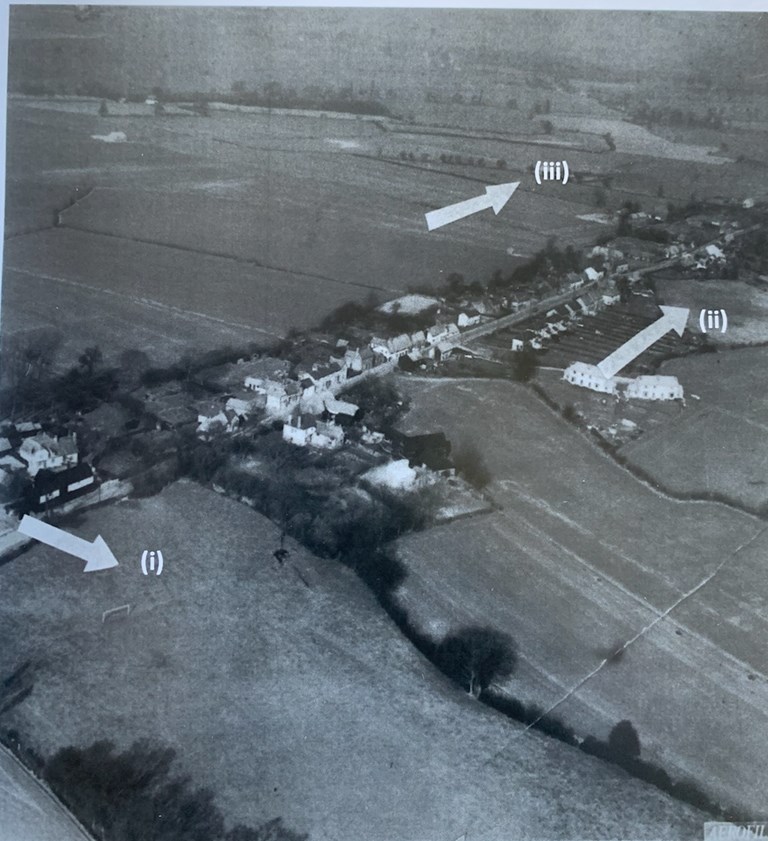
So after 125 years of cricket the Club are proud owners of a very picturesque, desirable and excellently maintained cricket ground.
Over the years the type of cricket has changed in many ways. For 100 years the Club played what was termed as ‘friendly’ cricket. Although in many ways local rivalry’s determined otherwise.
Colt coaching started in 1983. For a few years matches were friendly, but as the colts developed the Club joined the Central Essex Cricket Board and played league matches against the likes of Brentwood and Chelmsford. A couple of Colt Tours to East Sussex proved a huge success and enhanced the development of many.
The Meadows – 1989
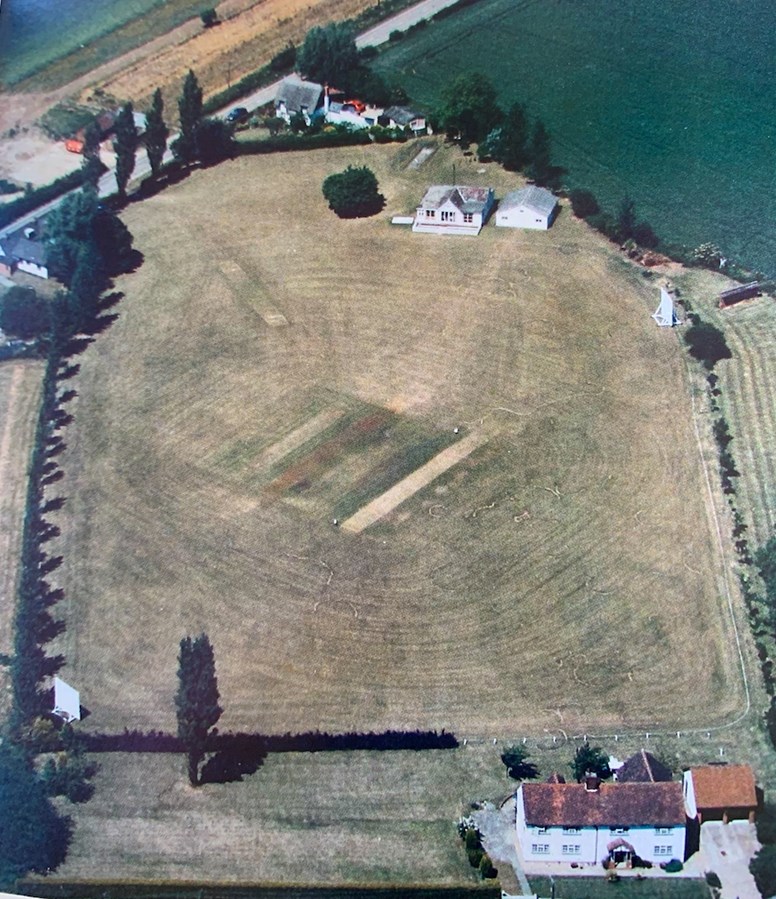
The progression of these colts continued such that in 1991, the Club joined the T. Rippon Mid-Essex Cricket League in Division 7. The Club made rapid progression through the divisions until being promoted to the Premier Division for the 2000 season, where they were runners-up. The Club has won the Premier Division on 4 occasions, including a hat-trick of wins 2002 – 2004, and again in 2010. In 1993, the Club became one of the founder members of the Herts and Essex League into which it put the second XI and then a third XI in 2008 albeit for only 3 years.
HRCC – HECL International T20 Winning Team (2012)
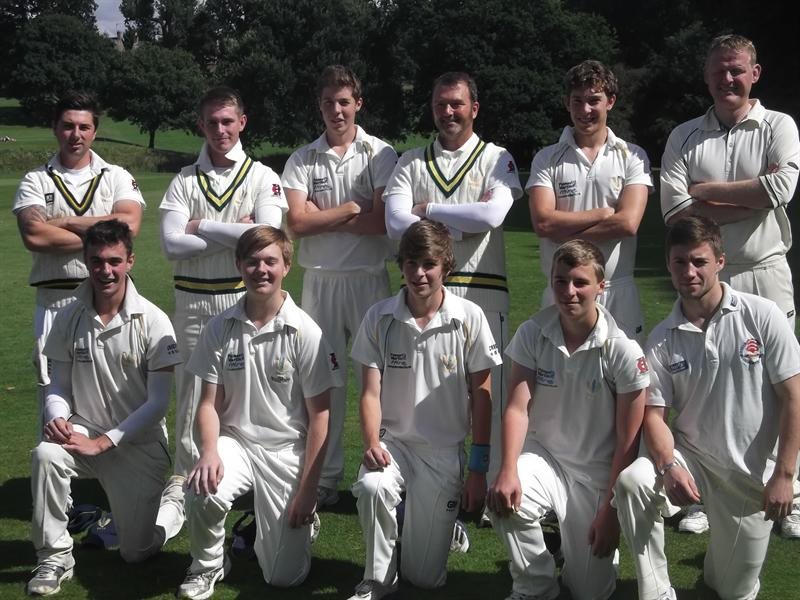
During this period the Club entered an evening cup competition, the Davies Cup. In 1990 it was the runner up, but went on to win the Cup in 1996, 2002, 2003, 2010, 2011 and 2014. No other club has that number of victories. The second XI hasn’t missed out, as they won the Herts & Essex Shield Cup in 2012.
In the mid 1980’s the Club went on its first Tour to Kent, which it did for 3 consecutive years. Subsequent Tours have taken place in Somerset, Devon, Yorkshire, Norfolk, and Worcester (including a midnight dip in the River Severn). In 2009 the Club went to Barbados, which provided warmer water for a dip!
The Club continually strives to improve its ground and facilities, to provide cricket for all as a stepping stone to improvement and success. The clubs most notable progressee is Tim Phillips who started as a colt and went on to represent Essex CC from 1999 until his retirement in 2014.
Another excellent cricketer to progress was Daryl Selby a natural ball player. Ultimately he chose squash as his career and reached a Ranking high on 9 in the World. No mean achievement.
The Club hopes that the successes at both senior and colt level in the past will continue into the future, and that cricket will be played and enjoyed at The Meadow for many more years.
It is fitting that our ladies should have the final word.
They have provided ‘claim-to-fame’ teas for endless years with delectable delights of homemade sandwiches, cakes and special sponges. They have supported the club at social events, and often been ‘cricket widows’ to their menfolk. However round the Centenary it was decided enough was enough! They formed their own team to play other village teams and do some charitable fundraising. Well done the ladies!
HRCC 2nd XI Team - After Playing their last game in the HECL (Division 4) in 2019 before moving to Mid-Essex Cricket League from 2020
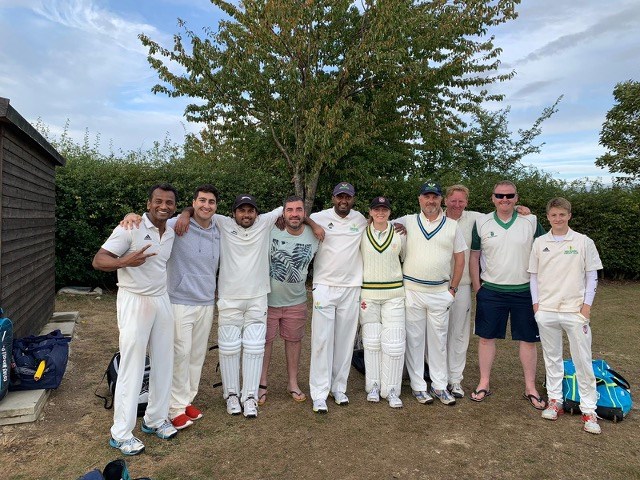
An aerial view of the ground in June 2021
